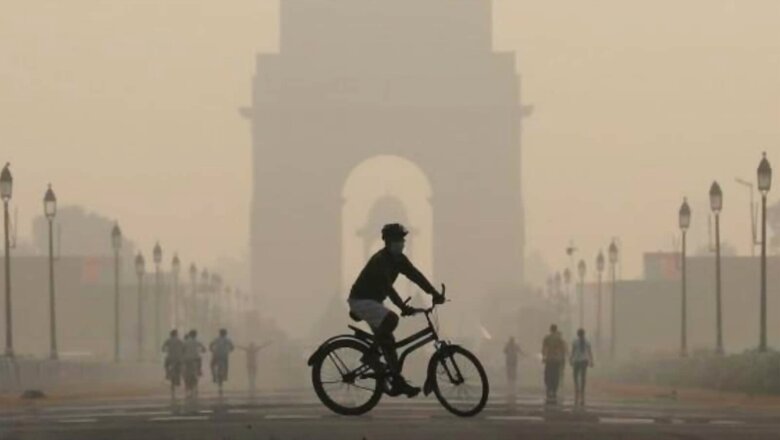
views
One of the biggest reasons for premature death and disease, air pollution acts as a silent killer worldwide. Most Indian megacities have also been dealing with the crisis of polluted air for a few decades now. The permissible limits of particulate matter and harmful gases are being exceeded in an increasing number of cities each year. The global focus for 2 years has been on dealing with the Covid-19 pandemic. Despite the fact that the virus has claimed more than 5 lakh lives in India, air pollution remains a greater concern. Furthermore, emerging research, including a study from Harvard T.H. Chan School of Public Health, finds that breathing more polluted air over many years may aggravate the effects of Covid-19.
More and more people are developing chronic respiratory and cardiac illnesses. As we move toward achieving Sustainable Development Goals by 2030, there is an urgent need to address and reduce the burden of diseases and deaths caused by polluted air.
Air Pollution and Outbreaks
Over the decades, several regional and global research studies have shown that there is a link between air pollutants and influenza-like illnesses. During the SARS outbreak in 2003, it was found that there is a positive correlation between air pollution levels and SARS case fatality in different Chinese cities. Later, a study conducted in 2012 showed that pre-exposure to ozone disrupts the protease/antiprotease balance found in the human airway, leading to increased influenza susceptibility. In the case of the coronavirus, a study was conducted in 2020 by the United Kingdom’s Office for National Statistics. The study revealed that long-term exposure to fine particulate matter could increase the risk of contracting and dying from Covid-19 by as much as 7%. As new kinds of viruses continue to emerge, there is a higher chance that people will become more vulnerable to them because of the presence of high amounts of air pollutants.
Also Read: Amid Covid Pandemic, Tuberculosis Patients Are Becoming a Casualty of Neglect
World Air Quality Report: India’s continued poor performance
The World Air Quality Report, prepared by Swiss organisation IQAir came out last week. It reveals that 35 Indian cities are in the top 50 most polluted cities of the world. Not only this, for the fourth consecutive year, Delhi continues to be the most polluted capital. After a decline in PM 2.5 concentrations in the air due to multiple lockdowns for two years, the report further revealed that now India’s air quality has deteriorated back to what it was in 2019. North India’s air quality at the moment is so bad that it can reduce the life expectancy of the people by as much as nine years due to the toxins.
Why is India susceptible to Air Pollution?
The majority of Indian cities ranked in the top 50 most polluted in the world are located in the country’s north. In his book “The Great Smog of India”, Siddharth Singh points out the “Meteorological Misfortune” that North Indian plains have to go through. He mentions that “air pollutants interact with suspended water droplets in the lower atmosphere to form a deadly smog blanket. This blanket obstructs the Sun, resulting in appallingly low visibility and unbreathable air.” The geographical and meteorological factors combine to make India and Indians vulnerable to the lethal and silent air pollution. Adding to this India currently being a developing nation produces many harmful gases. Having said this, it doesn’t mean that the state, policymakers and individuals can sit back and do nothing about it.
Also Read: Missing Females: COVID-19 Underreporting among Women Exposes a Persistent and Global Problem
Air Pollution and Ill Health
It is estimated that air pollution causes more than 1 lakh deaths each year in India. Breathing air in Delhi is said to be equivalent to smoking 10-15 cigarettes per day. Young people who have never smoked a single cigarette in their lives and have no family history of deathly diseases like lung cancer have started suffering from it. Many health issues caused by air pollution are not even visible in the short term. Pollution causes long-term effects that can last for even a lifetime. It causes diseases not only related to the lungs but also to nerves, the brain, kidneys, liver, and other organs. It can even cause birth defects. It also increases the risk of noncommunicable diseases such as diabetes and cardiac illness. Children, the elderly and pregnant women are more susceptible to air pollution-related diseases.
Making Air more breathable
In 2019, the government combined efforts to fight air pollution with the National Clean Air Programme (NCAP). It proposes a 20-30% reduction of air pollution by 2024. However, after a year in 2020, it had failed to legally enforce its targets and has remained effectively toothless. Without a legal mandate, the NCAP will not be able to implement the action plan.
There is a lack of data regarding Air pollution in this country. Cities like Delhi have 38 stations while our most populous state Uttar Pradesh has only 42. Collecting data and identifying sources of pollution is quite important. All year round data collection also becomes important due to the seasonal variation in air quality attributed to changes in wind, temperature and humidity. While we are seeing some success in reducing harm due to indoor air pollution, the decrease in the quality of outside air is negating that decrease. It also has been taken into consideration that we don’t want to stall economic progress which is helping millions of people out of poverty. A balance has to be maintained. Before we shut down a coal power plant, it should be made sure that a renewable power source is ready to replace it.
Pollution is an externality, something that somebody else does and causes other harm. The burden of this should shift to the polluter. For instance, the polluters should be held accountable and the cost of polluting be borne by them. Rules which dictate the time period in which farmers are allowed to sow paddy should be removed, so that need for stubble burning goes away. In order to address food scarcity, mandates like these are adding to bad winter days in many parts of the North Indian region.
In India, right now, outdoor air pollution has a higher chance of killing people than Covid-19. Effective and fast implementation of policies is required to eliminate the large burden of disease caused by contaminated air.
Mahek Nankani is Assistant Programme Manager, The Takshashila Institution. Harshit Kukreja is Research Analyst, at The Takshashila Institution. The views expressed in this article are those of the authors and do not represent the stand of this publication.
Read all the Latest Opinion News and Breaking News here




















Comments
0 comment